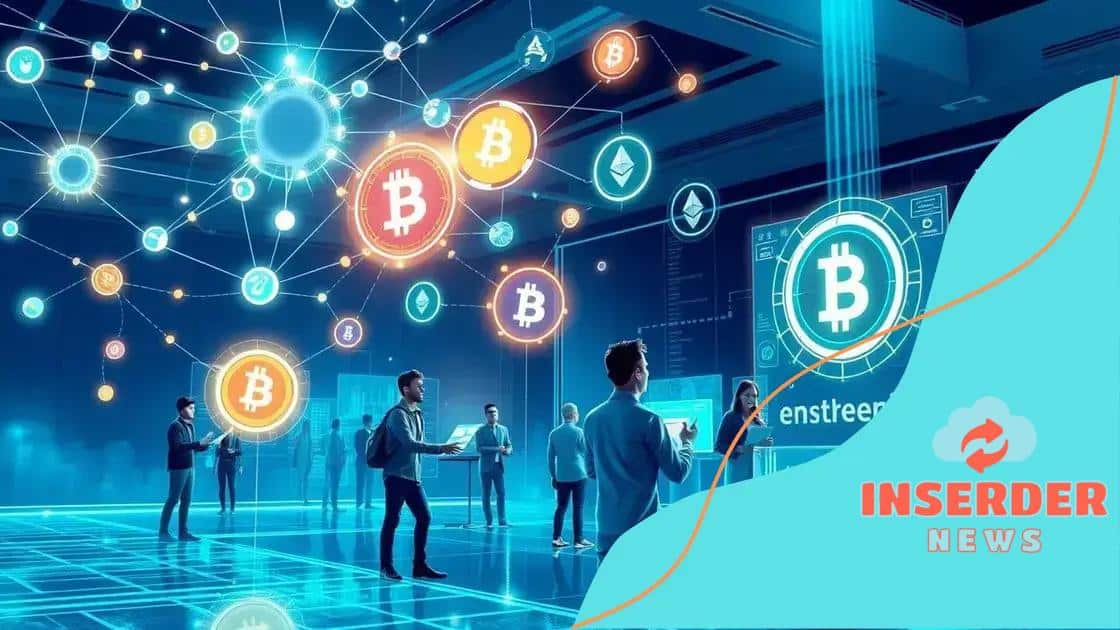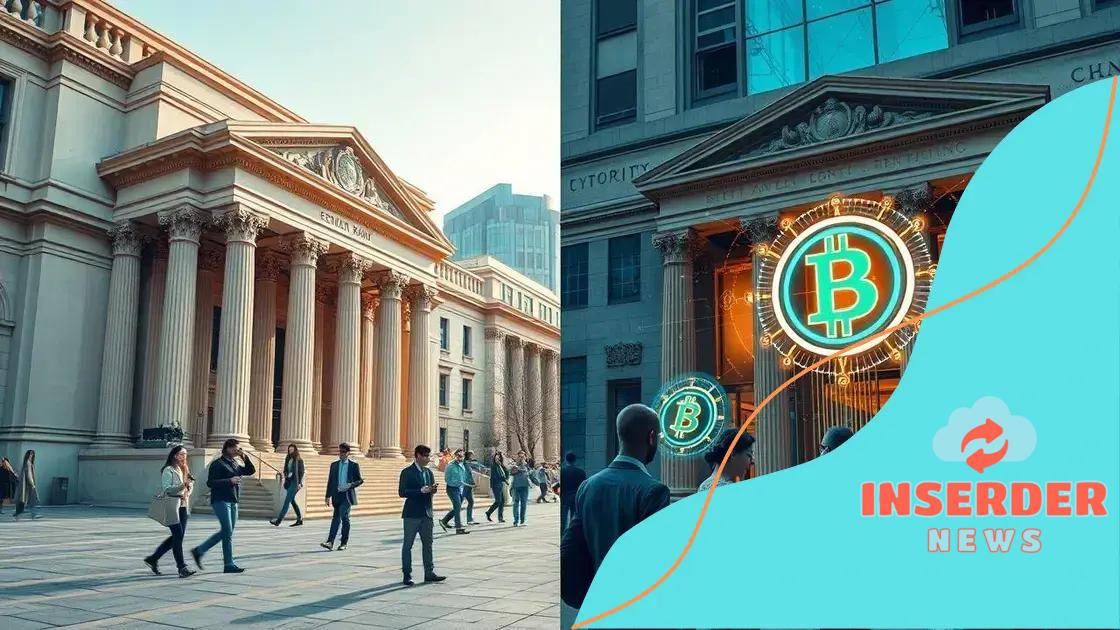The growth of decentralized finance (DeFi) in global markets

The growth of decentralized finance (DeFi) offers innovative financial services without intermediaries, but it also presents risks such as market volatility, smart contract vulnerabilities, and regulatory challenges that investors must navigate.
The growth of decentralized finance (DeFi) in global markets is transforming how we think about money and investment. Have you ever considered how DeFi might affect your financial decisions? Let’s dive into its potential.
Understanding decentralized finance (DeFi)
Understanding decentralized finance (DeFi) is crucial in today’s financial landscape. It represents a shift from traditional systems to a more open, accessible, and innovative financial ecosystem. This change allows people to engage with finance in ways that were previously impossible.
What is DeFi?
At its core, DeFi refers to financial services built on blockchain technology. Unlike traditional finance, where banks act as intermediaries, DeFi eliminates the need for these middlemen. This leads to a more direct relationship between users and financial applications.
Key Characteristics of DeFi
- Open access for everyone
- Transparency through blockchain
- Smart contracts that automate processes
- Global reach, bypassing traditional borders
The power of DeFi lies in its features. With open access, anyone with an internet connection can participate. This democratization of finance encourages innovation by enabling developers to create new applications that enhance the user experience.
Transparency is another significant aspect of DeFi. Since all transactions occur on a public ledger, users can verify activities and trust the system more readily. Smart contracts, which are self-executing contracts with the terms of the agreement directly written into code, play a vital role in automating and securing transactions. This reduces the risk of errors and fraud.
The Impact of DeFi on Traditional Finance
As DeFi grows, it poses challenges to traditional financial institutions. Traditional banks may find it difficult to compete with the flexibility and lower fees associated with decentralized platforms. Additionally, DeFi can enhance financial inclusion by providing financial services to underserved populations worldwide.
Understanding how DeFi operates goes beyond just its characteristics; it’s about recognizing its potential to redefine our financial future. As technology evolves, so will the opportunities for users and developers alike, creating a vibrant and diverse financial ecosystem.
Key drivers behind DeFi’s growth
Several key drivers are fueling the remarkable growth of decentralized finance (DeFi). Understanding these factors can provide insight into why DeFi is becoming a significant part of the global financial landscape.
Increased Access to Financial Services
One major driver is the increase in access to financial services. In traditional finance, many individuals are excluded due to high fees and complicated processes. DeFi offers a solution by providing open access to services without the need for intermediaries. This is particularly important in developing regions where banking infrastructure is limited.
Technological Advancements
Technological advancements also play a crucial role. Blockchain technology, which underpins DeFi, enables secure and transparent transactions. Innovations such as smart contracts further enhance this by automating processes and reducing reliance on human intervention. As technology evolves, more efficient and user-friendly platforms are emerging.
Community and Collaboration
The DeFi space thrives on community and collaboration. Developers work together in open-source environments to create new financial products. This collaborative spirit drives innovation and allows for continual improvement in the services offered. Additionally, user engagement in governance models fosters a sense of ownership among participants, which can attract more users.
- Innovative financial products
- Competitive fees and lower costs
- Enhanced security protocols
- Growth of stablecoins and liquidity pools
Competitive fees and lower transaction costs are another reason for DeFi’s growth. Lower fees can attract users looking for cost-effective solutions. Moreover, the growth of stablecoins, which minimize volatility, enhances user confidence in DeFi platforms.
Security is also paramount. Enhanced security protocols are necessary as the DeFi ecosystem expands. Developers continually work on improving these security measures to protect users from potential threats, increasing trust in decentralized platforms.
Comparing DeFi and traditional finance

Comparing decentralized finance (DeFi) and traditional finance reveals key differences and similarities in how both systems function within the economic landscape. Understanding these distinctions can help individuals make informed decisions about their finances.
Structure and Accessibility
The primary difference lies in structure and accessibility. Traditional finance relies on banks and financial institutions as intermediaries. Users must go through these intermediaries for services like loans, savings, and investments. In contrast, DeFi eliminates these intermediaries, allowing users to interact directly with financial applications through smart contracts. This approach enhances accessibility, especially for those without bank accounts.
Fees and Costs
Fees associated with traditional finance can be high. Transaction costs, service charges, and hidden fees add up, often discouraging users from fully engaging with financial services. In the DeFi world, lower fees are a significant draw. Since there are no intermediaries to pay, costs can be minimized, enabling users to keep more of their money.
- Traditional finance: high service fees
- DeFi: lower transaction costs
- Potential for no fees with some services
- Fee transparency in DeFi
While DeFi offers lower fees, it does have potential risks. For example, users may face hidden costs related to network congestion or gas fees on blockchain platforms. However, many projects are aimed at increasing fee transparency to improve the user experience.
Security and Control
Security is another area where DeFi and traditional finance diverge. Traditional financial institutions are often targets for theft and fraud, but they typically have strong security measures in place, such as insurance on deposits. Conversely, DeFi offers users greater control over their assets. Users hold their private keys, which gives them full ownership and minimizes reliance on a centralized authority. However, this also comes with risks; if a user loses their private key, they may lose access to their funds permanently.
The difference in control also affects how disputes are handled. In traditional finance, users can contact customer support for assistance. In DeFi, support is often through community forums, making it essential for users to conduct their own research and understand the risks involved.
Future trends in DeFi markets
The future of decentralized finance (DeFi) markets appears promising, with several trends set to shape their evolution. Keeping an eye on these trends can help users and investors make informed decisions as the landscape continues to change.
Integration with Traditional Finance
One key trend is the rising integration of DeFi with traditional financial systems. As more financial institutions explore blockchain technology, we might see a hybrid model where DeFi and traditional finance coexist. This could provide users with more options and enhanced services, leveraging the strengths of both systems.
Growth of Decentralized Autonomous Organizations (DAOs)
Decentralized Autonomous Organizations, or DAOs, are also on the rise. These organizations allow users to participate in governance and decision-making processes through voting mechanisms. DAOs empower users and foster community involvement, making them a crucial part of the DeFi ecosystem.
- Increased user engagement
- Democratized decision-making
- Innovative project funding
- Flexibility in governance structures
The impact of DAOs can be profound, as they promote transparency and inclusivity. Users can vote on project development and funding, creating a sense of ownership in DeFi projects.
Enhanced Security Measures
As DeFi gains popularity, security will remain a top priority. Developers are focusing on enhancing security measures to protect users from hacks and vulnerabilities. This includes better auditing processes, insurance protocols, and user education.
With more sophisticated security, we can expect increased confidence from users and institutions alike. Improved security measures could facilitate more substantial investments into the DeFi space.
Interoperability Between Platforms
Another trend is enhancing interoperability among different DeFi platforms. As various projects work to allow seamless interaction with each other, users can move assets across networks with ease. This will improve liquidity and expand the range of services available.
Users can benefit significantly from these developments. A more interconnected DeFi ecosystem opens up numerous possibilities for trading, borrowing, and investing, as more platforms become compatible.
Risks and challenges of DeFi investment
Investing in decentralized finance (DeFi) can be exciting, but it comes with its own set of risks and challenges. Understanding these factors can help you make informed decisions and protect your investment.
Market Volatility
One of the primary risks of DeFi investment is market volatility. The prices of cryptocurrencies and tokens can swing dramatically in short periods. This volatility can lead to significant gains, but it can also result in substantial losses.
Smart Contract Vulnerabilities
Another challenge relates to smart contract vulnerabilities. Smart contracts are self-executing agreements coded on the blockchain. If there are bugs or flaws in the code, hackers may exploit them, leading to theft or loss of funds. Developers are continually working to improve security, but risks remain.
- Potential for hacks and exploits
- Inadequately tested contracts
- Complexity of code increases vulnerability
- Need for regular audits and improvements
The complexity of smart contracts can create additional risks. As contracts become more intricate, the likelihood of overlooking vulnerabilities increases. Users must be diligent and research projects to ensure they are investing wisely.
Lack of Regulations
DeFi operates largely outside traditional financial regulations. This lack of oversight presents challenges. It means that there may be limited recourse for users in cases of fraud or failure. If a project fails, users may have no legal protections, unlike in traditional finance.
Moreover, the regulatory landscape for DeFi is rapidly changing. Governments worldwide are beginning to look at DeFi closely, which may lead to new regulations that could impact investments. Keeping informed about these changes is crucial for investors.
Liquidity Issues
Liquidity is another important factor to consider. In any investment, liquidity refers to how quickly an asset can be converted into cash without affecting its price. In DeFi, some tokens might lack sufficient liquidity, making it difficult to sell them at a desired price.
Investors should be cautious of projects with low liquidity. Participating in the market requires understanding the liquidity of the tokens involved to avoid getting stuck with assets that cannot be sold easily.
In conclusion, investing in decentralized finance (DeFi) offers exciting opportunities but also comes with notable risks and challenges. As the DeFi landscape continues to grow, understanding these elements is crucial. Factors like market volatility, smart contract vulnerabilities, regulatory changes, and liquidity issues can significantly impact your investments. Therefore, it is essential to stay informed and aware of these aspects while navigating the world of DeFi.
FAQ – Frequently Asked Questions about Decentralized Finance (DeFi)
What is decentralized finance (DeFi)?
DeFi refers to a system of financial services built on blockchain technology that eliminates intermediaries, allowing users to engage directly with financial applications.
What are the main risks of investing in DeFi?
The main risks include market volatility, smart contract vulnerabilities, lack of regulation, and liquidity issues.
How can I ensure the security of my DeFi investments?
To ensure security, research projects thoroughly, avoid poorly audited smart contracts, and use wallets that offer strong security features.
Are there any fees associated with DeFi transactions?
Yes, DeFi transactions may involve fees, often referred to as gas fees, which can vary based on network congestion.






